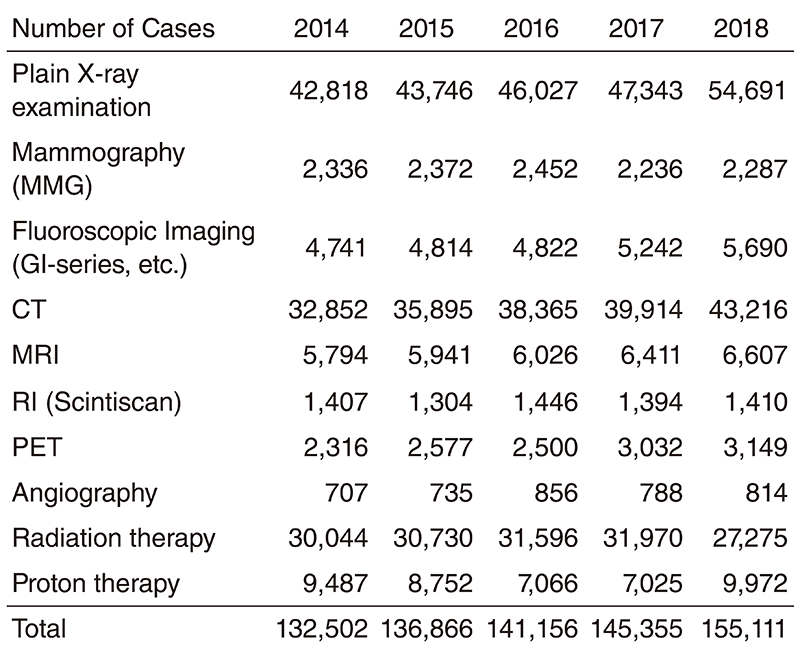Annual Report 2018
Department of Radiological Technology
Yoshihisa Muramatsu, Shoichi Katsuta, Kazutoshi Yokoyama, Yuichi Nagai, Masashi Iseya, Takaki Ariji, Akira Inagaki, Naotaka Yamazawa, Atsuko Takada, Satoe Kito, Tsunemichi Akita, Hajime Oyoshi, Kaoru Ikeno, Hiroyuki Ota, Shuhei Ohashi, Keiichi Nomura, Asami Tanaka, Shogo Amano, Daiki Kumagai, Ryuzo Uehara, Yuki Tanaka, Shun Aoyagi, Hikari Sugahara, Kaori Yanagisawa, Toshiyuki Shibuya, Kazuya Mizuguchi, Yuto Iwabuchi, Kota Hirotaki, Kazuto Kano, Toshiya Rachi, Daiki Kanke, Taku Tochinai, Yohei Takeda, Mayu Wakabayashi, Chikara Mano, Naoki Yamashita, Hikari Inagawa, Moeka Mizuguchi, Takashi Someya, Hiroaki Sagara, Yumika Hirai, Nene Hashizume, Takara Watanabe, Ken Hirayama, Maiko Sakurai, Keigo Hoshi
Introduction
The number of radiological examinations continues to increase as in recent years (Table 1), particularly the number of X-ray CT examinations and high-precision radiotherapy.
Table 1. Transition of number of radiological examination and radiation therapy by year.


The Team and What We Do
Large-scale structural changes in the diagnostic area (moving of angiography rooms, expansion of X-ray CT examination rooms, new waiting spaces, etc.) have been implemented across the year. The MRI system has been fully updated and the adoption of compressed sensing has helped streamline examinations. In the RI section, I-131 ablation treatment for residual thyroid cancer was started and work was also conducted on establishing systems for radioactivity management and image quality optimization of PET / CT examination. In photon radiotherapy, the treatment planning system was enhanced with a LINAC update, which made it possible to display treatment plans and dose distribution in each examination room. In addition, clinical application of the automatic planning function is ongoing. For proton radiotherapy, IMPT (Intensity-Modulated Proton Therapy), a technique that scans a proton beam from multiple directions and delivers an ideal dose, was applied to the head and neck region.
Research activities and Clinical trials
As part of joint research with a company, an automatic PET injector with medical information functions and a system for centrally managing radioactivity and image quality were newly developed and a joint patent application was also filed alongside. The X-ray CT section proposed Automatic Protocol Select and visited two US facilities to discuss feasibility. In photon radiotherapy, the performance characteristics of the newly adopted treatment planning device were evaluated and it was confirmed that dose distribution superior to the previous one could be created in a short time via the automatic planning function. In the proton radiotherapy system, high-definition and accuracy control methods for IMPT were studied and clinical applications were realized.
Education
The NCCE Radiologic Technology Conference, which was established from the previous year, was held three times a year as planned. Here, we would like to establish a cooperative system with the To-katsu Imaging Group and a venue for transmitting radiological technology-related information in cooperation with facility staff in the surrounding area. As a result of training on human resources, two persons completed the Master's program, two persons passed the Promotion test for candidate chief technologists in NHO, one person qualified as first class radiation protection supervisor, one person as an X-ray CT certified technologist, two persons as certified technologists for Breast Cancer Screening and one person each as radiation therapy specialist and sanitary engineering hygiene administrator. In addition, five clinical internships were commissioned from three training schools for medical radiological technologists, to which instructors were also dispatched. Six technologists also gave lectures at the "Nursing Course for Certified Nurses for Cancer Radiotherapy Nursing".
Future prospects
In the next fiscal year, replacement of medical radiographers with other departments (Medical Information Department, Clinical Coordinator division) is planned. Radiological Technologists are expected to be active in wideranging fields, over and above radiation work alone.
List of papers published in 2018
Journal
1. Yamazaki D, Miyazaki O, Takei Y, Matsubara K, Shinozaki M, Shimada Y, Suzuki S, Muramatsu Y. USEFULNESS OF SIZE-SPECIFIC DOSE ESTIMATES IN PEDIATRIC COMPUTED TOMOGRAPHY: REVALIDATION OF LARGE-SCALE PEDIATRIC CT DOSE SURVEY DATA IN JAPAN. Radiat Prot Dosimetry, 179:254-262, 2018
2. Fujii K, Nomura K, Muramatsu Y, Obara S, Goto T, Akahane K, Ota H, Tsukagoshi S, Kusumoto M. VALIDATION OF MONTE CARLO DOSE CALCULATION FOR PAEDIATRIC CT EXAMINATIONS USING TUBE CURRENT MODULATION BASED ON IN-PHANTOM DOSIMETRY. Radiat Prot Dosimetry, 182:508- 517, 2018
3. Arai T, Nagashima C, Muramatsu Y, Murao K, Yamaguchi I, Ushio N, Hanai K, Kaneko M. Can radiological technologists serve as primary screeners of low-dose computed tomography for the diagnosis of lung cancer? J Xray Sci Technol, 26:909-917, 2018
